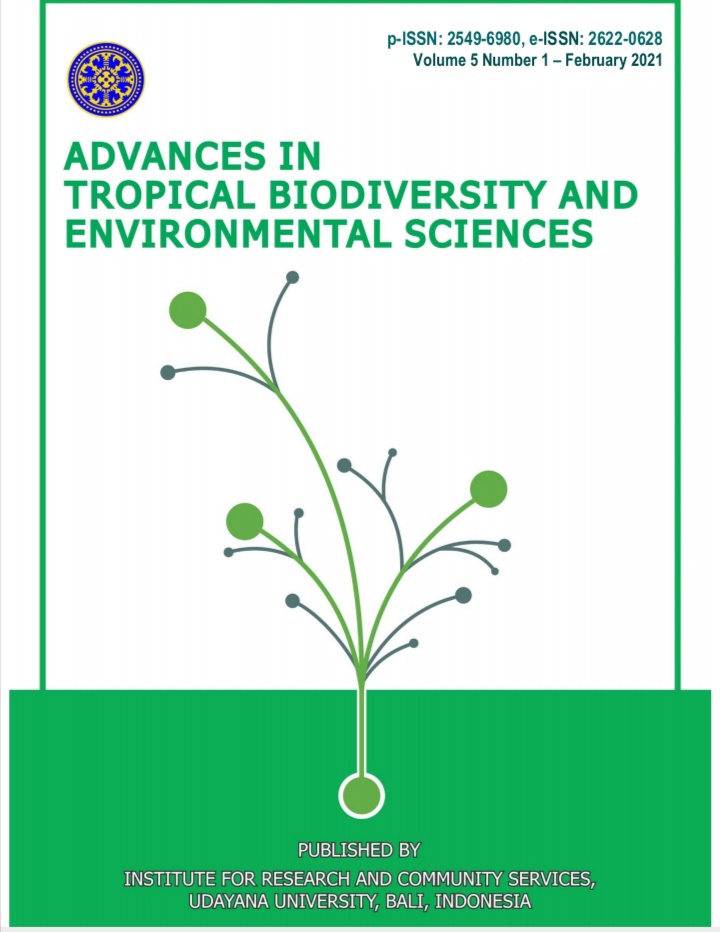The Rare Plants in The Alas Kedaton Tourism Forest, Tabanan, Bali
Abstract
Forests are a source of foreign exchange that has been exploited on a large scale for timber. This exploitation causes a rapid reduction in forest area. Until now, the destruction of the forest environment is still happening, both by illegal logging and illegal mining. This study aims to determine the number of rare plant species in Alas Kedaton Tourism Forest, Tabanan, Bali, Indonesia; and the factors causing the rarity of these plant species. The population in this research is the plant species in Alas Kedaton Tourism Forest. Meanwhile, the social population is all people in the Alas Kedaton Tourism Forest area. The sampling method for plant species is the quadratic method was used to investigate the diversity and the number of rare plants. While for the social sampling was conducted by interviewing with purposive sampling method to the local community around the Alas Kedaton areas. Determination of endangered plant species was conducted by studying of available documents, in-depth interviewing, and seeking information from various existent sources. The collected data analyzed descriptively. The results of this study indicated there are 48 species of plants with 26 families, which are generally found in Alas Kedaton Tourism Forest. Of this number, 42 (87.5%) plant species are included in the rare category; (2) of the 42 species of rare plants in the Alas Kedaton Tourism Forest, there are 8 (19.04%) plant species that are included in the National rare category, 20 (47.62%) rare plant species in Bali, 10 ( 23.81%) rare plant species in Tabanan Regency, and 4 (9.52%) species included in the rare category at the District level (especially Marga District); and (3) factors causing the scarcity of plant species in Alas Kedaton Tourism Forest are (a) past environmental degradation, (b) reproductive problems of rare plants, (c) human intervention, (4) disturbance by animals, especially long tailed monkeys (Macaca fascicularis) and bats (Pteropus vampyrus).
Downloads
References
[2] Wijana, N., IN Sumardika. 2005. Analsis Vegetasi Hutan Bukit Kangin Desa Adat Tenganan Pengringsingan, Kabupaten Karangasem. Research Institutin (not published).
[3] Wijana, N., M Sutajaya, N Kariasa. 2006. Analisis Kualitas Air, Aspek Kesehatan Masyarakat, Vegetasi Penyangga dan Upaya Pengelolaan oleh Masyarakat Seputar Danau Batur Kecamatan Kintamani Kabupaten Bangli. Research Institutin (not published).
[4] Wijana, N. 2009. Pelestarian Jenis-Jenis Tumbuhan Berguna Melalui Kearifan Lokal di Desa Adat Tenganan Pegringsingan, Kabupaten Karangasem, Bali. Dimuat dalam prosiding Konservasi Flora Indonesia dalam Mengatasi Dampak Pemanasan Global. Kebun Raya “Eka Karya – LIPI. Hal. 724 - 731. ISBN 978-979-799-447-1.
[5] Wijana, N., IBJ Swasta, IN Sumardika. 2010. Analisis ABC Environment pada Ekosistem Tumpang Tindih (Overlap Ecosystem) dalam Kaitannya dengan Penurunan Kualitas Air, Eutrofikasi, dan Rencana Pemantauan Lingkungan (RPL) Danau Buyan Kecamatan Sukasada Kabupaten Buleleng. Research Institutin (not published).
[6] Wijana, N. 2012. Analisis Dampak Lingkungan Dan Upaya Pengelolaan Berbasis Ergologi Kawasan Wisata Lovina, Buleleng – Bali. Research Institutin (not published).
[7] Wijana, N. 2013a. Analisis Vegetasi Hutan Adat, Upaya Pengelolaan Berbasis Kearifan Lokal dan Pemberdayaan Masyarakat Melalui Pendekatan Ergologi di Desa Bali Aga Buleleng-Bali. Research Institutin (not published).
[8] Wijana, N. 2013b. Analisis Komposisi dan Keanekaragaman Spesies Tumbuhan di Hutan Desa Bali AgaTigawasa, Buleleng – Bali. Jurnal Sains dan Humaniora Lemlit Undiksha. 1(1): 55-65.
[9] Wijana, N. 2014. Metode Analisis Vegetasi. Jogjakarta: Graha Ilmu.
[10] Wijana, N. 2016a. Pengelolaan Lingkungan Hidup (Aspek Kearifan Lokal, Ergonomi, Ergologi, dan Regulasi). Singaraja: Undiksha Press.
[11] Wijana, N. 2016b. Analisis Kualitas Lingkungan ditinjau dari aspek ABC Enviruntment di Kawasan Wisata Toya Bungkah, Bangli. Research Institutin (not published).
[12] Wijana, N. 2016c. Penentuan Titik-titik Rawan Erosi Sepanjang Jalur Wisata Bedugul-Singaraja. Research Institutin (not published).
[13] Wijana, N., IGAN Setiawan. 2017. Plant Species Mapping and Density in The Village Forest of Penglipuran, Bangli, Bali, Indonesia and Its use in Learning Media. Journal of Natural Science and Engineering. Vol. 1 (3) pp.80-91.
[14] Wijana, N., IGAN Setiawan. 2018a. Distribution and Comparison of Body Symbol (Tri Angga) Species in Bali Age and Bali Majapahit Communities at Trimandala in Bali Province. Research Report. Universitas Pendidikan Ganesha
[15] Wijana, N and IGAN Setiawan. 2019a. Mapping and Distribution of Useful Plant Species in Bukit Kangin Forest, Pegringsingan Village, Karangasem, Bali. International Conference on Innovative Research Accros Discipline (ICIRAD. 2019.
[16] Wijana, N., IGAN Setiawan. 2019b. Mapping and Distribution of Useful Plants, Preservation Efforts and Design of Development of Indigenous Forests as Creative Tourism Objects in the Bali Traditional Forest of Tenganan Pegringsingan, Bali Province. Research Report.
[17] Wijana, N., IGAN Setiawan. 2019c. The Utilization of Useful Plant Species Based on Socio-Cultural of Tenganan Pegringsingan Bali Aga village, District of Karangase, Bali. International Conference on Matemathics and Natural Science (ICONMNS 2019)
[18] Wijana, N., S Mulyadiharja. 2020a. Pelestarian dan Pemanfaatan Lingkungan Hidup Dalam Menunjang Desa Wanagiri Sebagai Desa Wisata. Makalah disampaikan pada semiar Nasional Pengabdian Masyarakat (Snadimas) ke 5 Tanggal 5 Oktober 2020
[19] Wijana, N., IGAN Setiawan, Sanusi Mulyadiharja, I Gede Astra Wesnawa, Putu Indah Rahmawati. 2020. Environmental Conservation Through Study Value of Bali Aga Tenganan Pegringsingan Community Culture. Journal Media Komunikasi Geografi, 21(1): 27-39. http://dx.doi.org/10.23887/mkg.v20i2.21903.
[20] Arrijani, D Setiadi, E Guhardja, I Qayim. 2006. Analisis Vegetasi Hulu DAS Cianjur Taman Nasional Gunung Gede-Pangrango. Jurnal Biodiversitas. Vol.7 No. 2, April 2006. h: 147-153.
[21] Hartini, S. 2007. Keragaman Flora dari Monumen Alam Kersik Luway Kalimantan Timur. Jurnal Biodiversitas Vol. 8, Nomor 1. Januari 2007. hal. 67-72. ISSN 1412-083.
[22] Purwaningsih. 2006. Analisis Vegetasi Hutan pada Beberapa Ketinggian Tempat di Bukit Wawouwai, Pulau Wawonii Sulawesi Tenggara”. Jurnal Biodiversitas, Volume 7, Nomor 1. Januari 2006. ISSN 1412-083 (hal. 49-53).
[23] Purwaningsih dan Razali Yusuf. 2008. “Analisis Vegetasi Hutan Pegunungan di Taman Nasional Gunung Ciremai, Majalengka, Jawa Barat”. Jurnal Biologi Indonesia 4 (5): 385-399 Tahun 2008.
[24] Junaedi, D Indrawan, Z Mutaqien. 2010. “Diversity of Tree Communities in Mount Patuha Region, West Java”. Biodiversitas, 11(2): 75-81.
[25] Onrizal, C Kusmono, BH Saharjo, IP Handayani, T Koto. 2006. ”Analisis Vegetasi Hutan Hujan Tropika Dataran Rendah Sekunder di Taman Nasional Danau Sentarum, Kalimantan Barat”. Jurnal Biologi, 4(6): 359-371.
¬¬¬¬¬¬¬
[26] Sujaya. 2007. Warga Kukuh Pantang Tebang Pohon di Alas Kedaton. Terdapat pada alamat web http://www.duniasa.net78.net/alaskedaton.html (access on January, 1st 2016).
[27] Cox, G.W. 1976. Laboratory Manual of General Ecology. WM. C. Brown Company Publisher, USA
[28] Barbour, Michael G; Jack H. Burk, Wanna D. Pitts. 1987. Terrestrial Plant Ecology. California: The Benjamin / Cummings Publishing Company, Inc.
[29] Mueller – Dombois, Dieter and Heinz Ellenberg. 1974. Aims and Methods of Vegetation Ecology. New York: John Willey & Sons.
[30] Ludwig, Jhon. A. and Reynolds, James F. 1988. Statistical Ecology. New York: Jhon Willey and Sons.
[31] Indriyanto.2008. Ekologi Hutan. Cetakan ke-2. Jakarta: Bumi Aksara
[32] Sugita, W. 2015. Dampak Perkembangan Pariwisata Terhadap Keberlanjutan Usahatani Rumput Laut Di Desa Kutuh, Kuta Selatan Kabupaten Badung. Denpasar: Universitas Udayana.
[33] Sarna, K., Made, R., dan Ngurah, S. 1993. Inventarisasi dan Pelestarian Tanaman Langka di Bali Dalam Usaha Menunjang Obyek Wisata dan Studi. Denpasar: Fakultas Keguruan dan Ilmu Pendidikan Universitas Udayana
[34] Soemarwoto, O. 1991. Indonesia dalam Kancah Isu Lingkungan Global. Jakarta: PT. Gramedia Pustaka Utama













